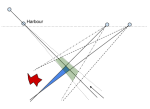Bi111ion
Well-Known Member
I think the point of all this is that you could be closer than the nearest corner. It's made me more thankful for GPS.
Yes that is the point.
Of course the principle applies to GNSS such as GPS. Fortunately you typically have a lot of satellites in view under normal conditions at sea. The probability contours are still ellipses, but with enough sats and enough averaging they tend to be close to circular and so the reported error in metres is a pretty good guide. If the GNSS signals were being jammed or spoofed, but you were able to get a few reliable signals but at unfavourable angles the same principle would hold. Each pair of sats gives you a hyperboloid of position but on a small scale this looks like a line (just as in celestial navigation a LOP is really part of a circle).



